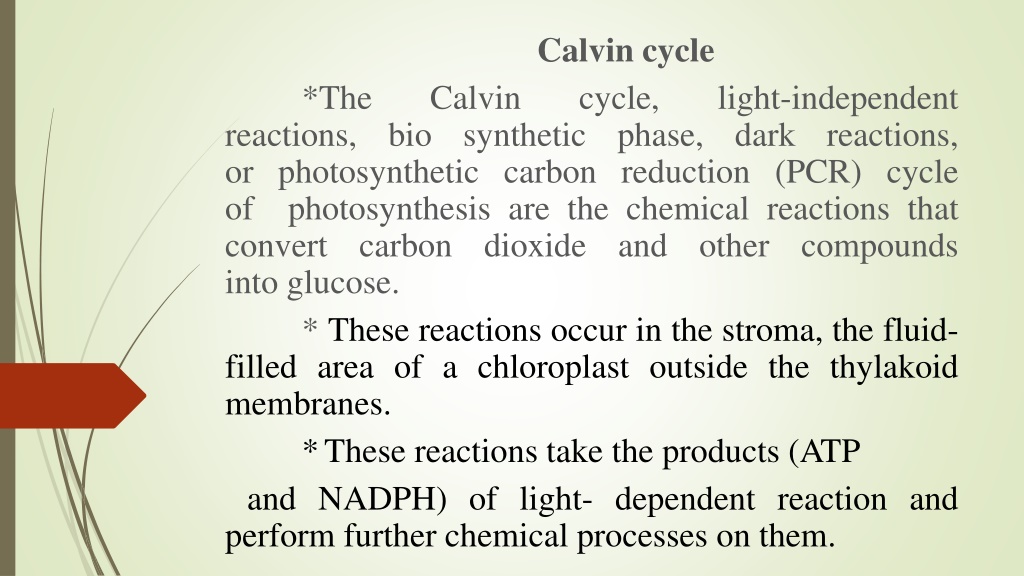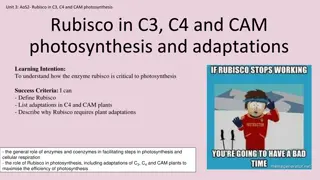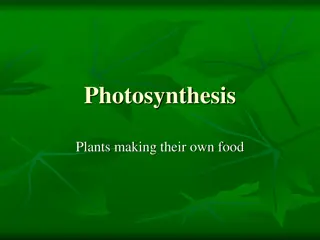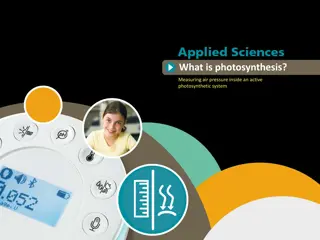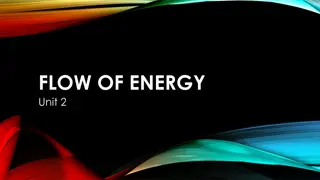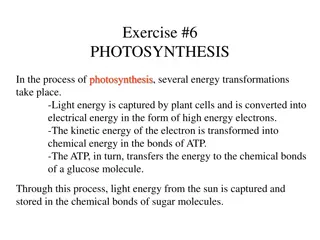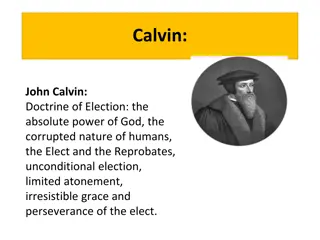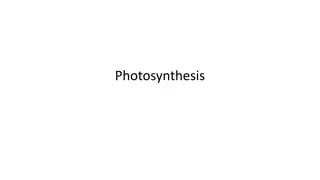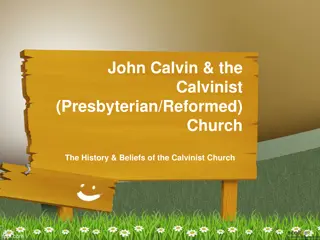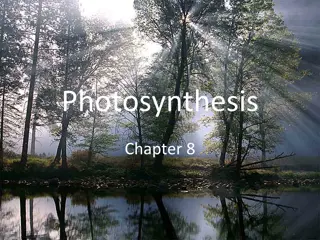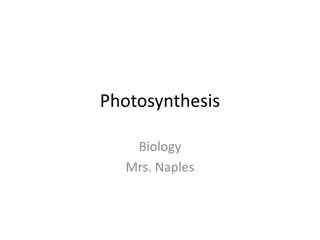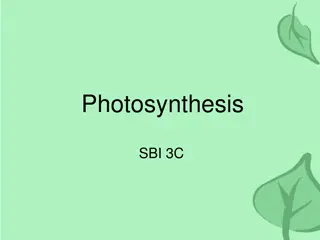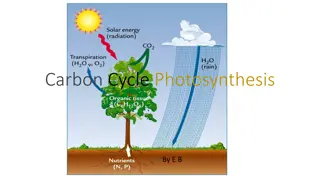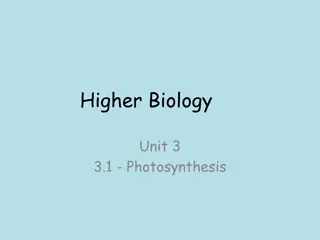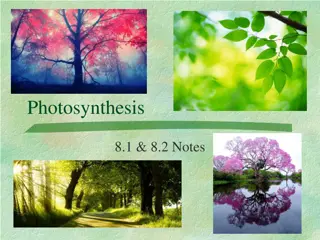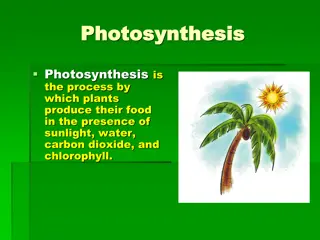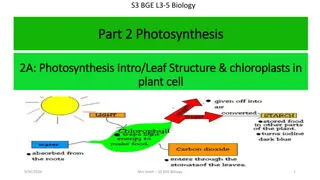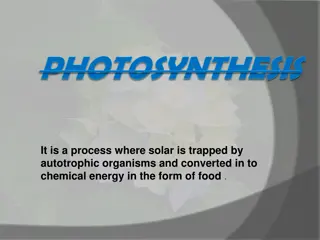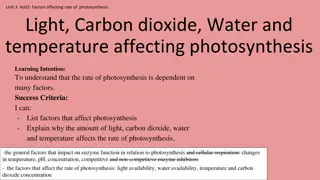Understanding the Calvin Cycle in Photosynthesis
The Calvin cycle, also known as the light-independent reactions, is a crucial part of photosynthesis where carbon dioxide is converted into glucose. This cycle occurs in the stroma of chloroplasts and utilizes ATP and NADPH from the light-dependent reactions to produce sugars for plants. It consists of three phases: carbon fixation, reduction reactions, and RuBP regeneration. Despite being termed "dark reactions," the Calvin cycle requires light indirectly. The cycle was discovered in 1950 and involves the key enzyme RuBisCo. Enzymes in the Calvin cycle are functionally similar to those in other metabolic pathways.
Download Presentation

Please find below an Image/Link to download the presentation.
The content on the website is provided AS IS for your information and personal use only. It may not be sold, licensed, or shared on other websites without obtaining consent from the author. Download presentation by click this link. If you encounter any issues during the download, it is possible that the publisher has removed the file from their server.
E N D
Presentation Transcript
Calvin cycle cycle, synthetic *The Calvin bio light-independent dark reactions, reactions, or photosynthetic carbon reduction (PCR) cycle of photosynthesis are the chemical reactions that convert carbon dioxide into glucose. * These reactions occur in the stroma, the fluid- filled area of a chloroplast outside the thylakoid membranes. *These reactions take the products (ATP and NADPH) of light- dependent reaction and perform further chemical processes on them. phase, and other compounds
*The Calvin cycle uses the reducing powers ATP and NADPH from the light dependent reactions to produce sugars for the plant to use. *These substrates are used in a series of reduction- oxidation reactions to produce sugars in a step-wise process. *There is not a direct reaction that converts CO2 to a sugar because all off the energy would be lost to heat. * There are three phases to the light-independent reactions, collectively called the Calvin cycle: carbon fixation, reduction reactions, bisphosphate (RuBP) regeneration. and ribulose 1,5-
* Though it is called the "dark reactions", the Calvin cycle does not actually occur in the dark or during nighttime. * This is because the process requires reduced NADP which is short-lived and comes from the light- dependent reactions. In the dark, plants instead release sucrose into the phloem from their starch reserves to provide energy for the plant. * The Calvin cycle thus happens when light is available independent of the kind of photosynthesis ( C3 carbon fixation, C4 carbon fixation, and Crassulacean Acid Metabolism (CAM); CAM plants store malic acid in their vacuoles every night and release it by day to make this process work.
* The cycle was discovered in 1950 by Melvin Calvin, James Bassham, and Andrew Benson at the University of California, radioactive isotope carbon -14. *Photosynthesis occurs in two stages in a cell. In the first stage, light-dependent reactions capture the energy of light and use it to make the energy-storage and transport molecules ATP and NADPH. * The Calvin cycle uses the energy from short- lived electronically excited carriers to convert carbon dioxide and water into organic compounds that can be used by the organism (and by animals that feed on it). Berkeley by using the
* This set of reactions is also called carbon fixation. The key enzyme of the cycle is called RuBisCo. In the following biochemical equations, the chemical species (phosphates and carboxylic acids) exist in equilibria among their various ionized states as governed by the pH. * The enzymes in the Calvin cycle are functionally equivalent to most enzymes used in other metabolic pathways such as gluconeogenesis and the pentose phosphate pathway but they are found in the chloroplast stroma instead of the cell cytosol, separating the reactions.
* They are activated in the light (which is why the name "dark reaction" is misleading), and also by products of the light-dependent reaction. * These regulatory functions prevent the Calvin cycle from being respired to carbon dioxide. Energy (in the form of ATP) would be wasted in carrying out these reactions that have no net productivity. *3 CO2+6 NADPH +6H++9 ATP Glyceraldehy de-3- phosphate (G3P) + 6 NADP++ 9 ADP + 3 H2O + 8 Pi(Pi= inorganic phosphate)
*In the first stage of the Calvin cycle, a CO 2 molecule is incorporated into one of two three- carbon molecules (glyceraldehyde 3- phosphate or G3P), where it uses up two molecules of ATP and two molecules of NADPH, which had been produced in the light-dependent stage. The three steps involved are: Step:1
*The enzyme RuBisCO catalyses the carboxylation of ribulose- 1,5- bisphosphate RuBP, a 5- carbon compound, by carbon dioxide (a total of 6 carbons) in a two-step reaction. The product of the first step is enediol-enzyme capture CO2or O2. Thus, enediol-enzyme complex is the real carboxylase/oxygenase. *The CO2that is captured by enediol in second step produces an unstable six-carbon compound called 2-carboxy 3-keto 1,5biphosphoribotol (or 3-keto-2- carboxyarabinitol 1,5-bisphosphate) that immediately splits into 2 molecules of 3-phosphoglycerate or 3-PGA, a 3-carbon compound (also: 3-phosphoglyceric acid, PGA, 3PGA). complex that can
phosphorylation of 3-PGA by ATP (which was produced in the light-dependent stage). 1,3 Bisphosphoglycerate (1,3BPGA, glycerate-1,3-bisphosphate) and ADP are the products. (However, note that two 3-PGAs are produced for every CO2 that enters the cycle, so ATP per CO2fixed.) *The enzyme glyceraldehyde dehydrogenase catalyses the reduction of 1,3BPGA by NADPH (which is another product of the light-dependent stage). Glyceraldehyde 3-phosphate (also called G3P, GP, TP, PGAL, GAP) is produced, and the NADPH itself is oxidized and becomes NADP+. Again, two NADPH are utilized per CO2 fixed. *The enzyme phosphoglycerate kinase catalyses the this step utilizes two 3-phosphate
* The next stage in the Calvin cycle is to regenerate RuBP. Five G3P molecules produce three RuBP molecules, using up three molecules of ATP. Since each CO2 molecule produces two G3P molecules, three CO2 molecules produce six G3P molecules, of which five are used to regenerate RuBP, leaving a net gain of one G3P molecule per three CO2 molecules (as would be expected from the number of carbon atoms involved).
